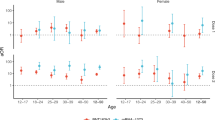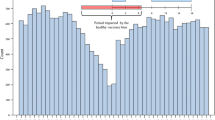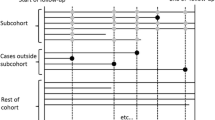Abstract
Many case-control studies have shown a protective effect of vaccinations on the risk of sudden unexplained death (SUD). In this paper we compare the properties of different statistical methods in this situation, when the first vaccination appears to reduce the overall risk of an event (SUD). The first method is the self controlled case series (SCCS) method, which considers only subjects with an event during the observation time. This method yields unbiased estimates in the situation of non-censoring events. We show by simulation studies that the second method considered, the adjusted SCCS method, underestimates the parameter of interest, the effect of the first dose, when the general risk of SUD is lower in control periods after the first vaccination than in the period before vaccination. This type of bias could be eliminated by considering only cases who had received at least one vaccination. Additionally, we compare the adjusted SCCS method with the Cox model as a third method. Cox regression can take into account the time before the first vaccination, and this method yields unbiased estimates at modest effect sizes and short risk periods. We applied the SCCS method and Cox regression to data from the German study on sudden infant death (GeSID) and to a case series study from Italy (the HERA study) examining sudden unexpected deaths and vaccinations during the first 2 years of life. We show that the adjusted SCCS analysis with all cases underestimates the vaccination effect, as expected from the simulation analyses. Using Cox regression, we examined the general risk reduction after vaccination, as was the focus of the above mentioned studies. With a relative incidence of 0.8, our results were less pronounced than in the case-control analysis of the GeSID study (adjusted odds ratio: 0.51). SCCS analyses of both the GeSID and HERA studies yielded very similar estimates for the first and second vaccine doses.




Similar content being viewed by others

References
Farrington CP, Whitaker HJ, Hocine MN (2009) Case series analysis for censored, perturbed or curtailed post-event exposures. Biostatistics 10:3–16
Farrington PC (1995) Relative incidence estimation from case series for vaccine safty evaluation. Biometrics 51:228–235
Fine PEM, Chen RT (1992) Confounding in studies of adverse reactions to vaccines. Am J Epidemiol 136:121–135
Kuhnert R, Hecker H, Poethko-Müller C, Schlaud M, Vennemann M, Whitaker HJ, Farrington CP (2011) A modified self-controlled case series method to examine association between multidose vaccinations and death. Stat Med 30(6):666–677
Kuhnert R, Schlaud M, Hecker H (2012a) Evaluation strategies for case series: is cox regression an alternative to the self controlled case series method for terminal events? AStA Adv Stat Anal 1–26 doi:10.1007/s10182-011-0187-9
Kuhnert R, Schlaud M, Poethko-Müller C, Vennemann M, Fleming P, Blair PS, Mitchell E, Thompson J, Hecker H (2012b) Reanalyses of case-control studies examining the temporal association between sudden infant death syndrome and vaccination. submitted in Vaccine (in press)
STIKO (1998) Empfehlung der Ständigen Impfkommission (STIKO) am Robert Koch-Institut/Stand Juli 1998. Epidemiol Bull 15:101–114
STIKO (2009) Empfehlung der Ständigen Impfkommission (STIKO) am Robert Koch-Institut/Stand Juli 2009. Epidemiol Bull 30:279–298
Traversa G, Spila-Alegiani S, Bianchi C, Ciofi degli Atti M, Frova L, Massari M, Raschetti R, Salmaso S, Scalia Tomba G, Hera Study Group (2011) Sudden unexpected deaths and vaccinations during the first two years of life in Italy: a case series study. PLoS One 6(1):e16363
Vennemann MM, Findeisen M, Butterfass-Bahloul T, Jorch G, Brinkmann B, Köpcke W, Bajanowski T, Mitchell EA (2005) Modifiable risk factors for SIDS in Germany: results of GeSID. Acta Paediatrica 94(6):655–60
Vennemann MMT, Höffgen M, Bajanowski T, Hense HW, Mitchell EA (2007) Do immunisations reduce the risk for SIDS? A meta-analysis. Vaccine 25:4875–4879
Whitaker HJ, Farrington CP, Spiessens B, Musonda P (2006) Tutorial in biostatistics: the self-controlled case series method. Stat Med 25:1768–1797
Author information
Authors and Affiliations
Corresponding author
Appendix
Appendix
1.1 Definition of age classes
We derived the age classes included in adjusted SCCS models from the empirical age distribution of 318 GeSID cases divided into 21 age groups. Age class \(k\) has as its upper limit the \(k \times 4.76\)th percentile of the distribution. This ensures that each class has nearly the same number of cases. The definition of the second interval [30.00–37.19) is \(30.00 \le age_i < 37.19\). The round bracket indicates that the 37.19 is not included in the interval (Table 7).
Rights and permissions
About this article
Cite this article
Kuhnert, R., Spila-Alegiani, S., Tomba, G.S. et al. The association between multidose vaccinations and death: comparing case series methods when the first exposure changes the general risk of an event. Stat Methods Appl 22, 573–587 (2013). https://doi.org/10.1007/s10260-013-0244-5
Accepted:
Published:
Issue Date:
DOI: https://doi.org/10.1007/s10260-013-0244-5



